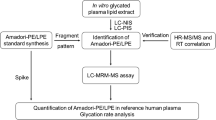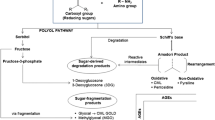Abstract
Recent instrumental analyses using a hybrid quadrupole/linear ion trap spectrometer in LC-MS/MS have demonstrated that the Maillard reaction progresses not only on proteins but also on amino residues of membrane lipids such as phosphatidylethanolamine (PE), thus forming Amadori-PE (deoxy-d-fructosyl PE) as the principal products. The plasma Amadori-PE level is 0.08 mol% of the total PE in healthy subjects and 0.15–0.29 mol% in diabetic patients. Pyridoxal 5′-phosphate and pyridoxal are the most effective lipid glycation inhibitors, and the PE-pyridoxal 5′-phosphate adduct is detectable in human red blood cells. These findings are beneficial for developing a potential clinical marker for glycemic control as well as potential compounds to prevent the pathogenesis of diabetic complications and atherosclerosis. Glucose and other aldehydes, such as glyoxal, methylglyoxal, and glycolaldehyde, react with the amino residues of proteins to form Amadori products and Heynes rearrangement products. Because several advanced glycation end-product (AGE) inhibitors such as pyridoxamine and benfotiamine inhibit the development of retinopathy and neuropathy in streptozotocin (STZ)-induced diabetic rats, AGEs may play a role in the development of diabetic complications. In the present review, we describe the recent progress and future applications of the Maillard reaction research regarding lipid and protein modifications in diabetes and atherosclerosis.



Similar content being viewed by others
References
Araki N, Ueno N, Chakrabarti B, Morino Y, Horiuchi S (1992) Immunochemical evidence for the presence of advanced glycation end products in human lens proteins and its positive correlation with aging. J Biol Chem 267:10211–10214
Asai A, Okajima F, Nakagawa K, Ibusuki D, Tanimura K, Nakajima Y, Nagao M, Sudo M, Harada T, Miyazawa T, Oikawa S (2009) Phosphatidylcholine hydroperoxide-induced THP-1 cell adhesion to intracellular adhesion molecule-1. J Lipid Res 50:957–965
Baynes JW (1991) Role of oxidative stress in development of complications in diabetes. Diabetes 40:405–412
Bucala R, Makita Z, Koschinsky T, Cerami A, Vlassara H (1993) Lipid advanced glycosylation: pathway for lipid oxidation in vivo. Proc Natl Acad Sci USA 90:6434–6438
Cai W, He JC, Zhu L, Lu C, Vlassara H (2006) Advanced glycation end product (AGE) receptor 1 suppresses cell oxidant stress and activation signaling via EGF receptor. Proc Natl Acad Sci USA 103:13801–13806
Hammes HP, Weiss A, Hess S, Araki N, Horiuchi S, Brownlee M, Preissner KT (1996) Modification of vitronectin by advanced glycation alters functional properties in vitro and in the diabetic retina. Lab Invest J Tech Methods Pathol 75:325–338
Higashi T, Sano H, Saishoji T, Ikeda K, Jinnouchi Y, Kanzaki T, Morisaki N, Rauvala H, Shichiri M, Horiuchi S (1997) The receptor for advanced glycation end products mediates the chemotaxis of rabbit smooth muscle cells. Diabetes 46:463–472
Higuchi O, Nakagawa K, Tsuzuki T, Suzuki T, Oikawa S, Miyazawa T (2006) Aminophospholipid glycation and its inhibitor screening system: a new role of pyridoxal 5′-phosphate as the inhibitor. J Lipid Res 47:964–974
Houjou T, Yamatani K, Nakanishi H, Imagawa M, Shimizu T, Taguchi R (2004) Rapid and selective identification of molecular species in phosphatidylcholine and sphingomyelin by conditional neutral loss scanning and MS3. Rapid Commun Mass Spectrom 18:3123–3130
Hricik DE, Schulak JA, Sell DR, Fogarty JF, Monnier VM (1993) Effects of kidney or kidney-pancreas transplantation on plasma pentosidine. Kidney Int 43:398–403
Imai N, Nishi S, Suzuki Y, Karasawa R, Ueno M, Shimada H, Kawashima S, Nakamaru T, Miyakawa Y, Araki N, Horiuchi S, Gejyo F, Arakawa M (1997) Histological localization of advanced glycosylation end products in the progression of diabetic nephropathy. Nephron 76:153–160
Jinnouchi Y, Sano H, Nagai R, Hakamata H, Kodama T, Suzuki H, Yoshida M, Ueda S, Horiuchi S (1998) Glycolaldehyde-modified low density lipoprotein leads macrophages to foam cells via the macrophage scavenger receptor. J Biochem 123:1208–1217
Kinoshita M, Oikawa S, Hayasaka K, Sekikawa A, Nagashima T, Toyota T, Miyazawa T (2000) Age-related increases in plasma phosphatidylcholine hydroperoxide concentrations in control subjects and patients with hyperlipidemia. Clin Chem 46:822–828
Kume S, Takeya M, Mori T, Araki N, Suzuki H, Horiuchi S, Kodama T, Miyauchi Y, Takahashi K (1995) Immunohistochemical and ultrastructural detection of advanced glycation end products in atherosclerotic lesions of human aorta with a novel specific monoclonal antibody. Am J Pathol 147:654–667
Lertsiri S, Shiraishi M, Miyazawa T (1998) Identification of deoxy-d-fructosyl phosphatidylethanolamine as a non-enzymic glycation product of phosphatidylethanolamine and its occurrence in human blood plasma and red blood cells. Biosci Biotechnol Biochem 62:893–901
Mera K, Nagai R, Haraguchi N, Fujiwara Y, Araki T, Sakata N, Otagiri M (2007) Hypochlorous acid generates N epsilon-(carboxymethyl)lysine from Amadori products. Free Radic Res 41:713–718
Mera K, Takeo K, Izumi M, Maruyama T, Nagai R, Otagiri M (2010) Effect of reactive-aldehydes on the modification and dysfunction of human serum albumin. J Pharm Sci 99:1614–1625
Miyata T, Oda O, Inagi R, Iida Y, Araki N, Yamada N, Horiuchi S, Taniguchi N, Maeda K, Kinoshita T (1993) beta 2-Microglobulin modified with advanced glycation end products is a major component of hemodialysis-associated amyloidosis. J Clin Invest 92:1243–1252
Miyata T, Taneda S, Kawai R, Ueda Y, Horiuchi S, Hara M, Maeda K, Monnier VM (1996) Identification of pentosidine as a native structure for advanced glycation end products in beta-2-microglobulin-containing amyloid fibrils in patients with dialysis-related amyloidosis. Proc Natl Acad Sci USA 93:2353–2358
Miyazawa T (1989) Determination of phospholipid hydroperoxides in human blood plasma by a chemiluminescence-HPLC assay. Free Radic Biol Med 7:209–217
Miyazawa T, Suzuki T, Fujimoto K, Yasuda K (1992) Chemiluminescent simultaneous determination of phosphatidylcholine hydroperoxide and phosphatidylethanolamine hydroperoxide in the liver and brain of the rat. J Lipid Res 33:1051–1059
Nagai R, Ikeda K, Higashi T, Sano H, Jinnouchi Y, Araki T, Horiuchi S (1997) Hydroxyl radical mediates N epsilon-(carboxymethyl)lysine formation from Amadori product. Biochem Biophys Res Commun 234:167–172
Nagai R, Matsumoto K, Ling X, Suzuki H, Araki T, Horiuchi S (2000) Glycolaldehyde, a reactive intermediate for advanced glycation end products, plays an important role in the generation of an active ligand for the macrophage scavenger receptor. Diabetes 49:1714–1723
Nagai R, Unno Y, Hayashi MC, Masuda S, Hayase F, Kinae N, Horiuchi S (2002) Peroxynitrite induces formation of N(epsilon)-(carboxymethyl) lysine by the cleavage of Amadori product and generation of glucosone and glyoxal from glucose: novel pathways for protein modification by peroxynitrite. Diabetes 51:2833–2839
Nagai R, Mera K, Nakajou K, Fujiwara Y, Iwao Y, Imai H, Murata T, Otagiri M (2007) The ligand activity of AGE-proteins to scavenger receptors is dependent on their rate of modification by AGEs. Biochim Biophys Acta 1772:1192–1198
Nagashima T, Oikawa S, Hirayama Y, Tokita Y, Sekikawa A, Ishigaki Y, Yamada R, Miyazawa T (2002) Increase of serum phosphatidylcholine hydroperoxide dependent on glycemic control in type 2 diabetic patients. Diabetes Res Clin Pract 56:19–25
Nakagawa K, Oak JH, Higuchi O, Tsuzuki T, Oikawa S, Otani H, Mune M, Cai H, Miyazawa T (2005) Ion-trap tandem mass spectrometric analysis of Amadori-glycated phosphatidylethanolamine in human plasma with or without diabetes. J Lipid Res 46:2514–2524
Nishikawa T, Edelstein D, Du XL, Yamagishi S, Matsumura T, Kaneda Y, Yorek MA, Beebe D, Oates PJ, Hammes HP, Giardino I, Brownlee M (2000) Normalizing mitochondrial superoxide production blocks three pathways of hyperglycaemic damage. Nature 404:787–790
Oak J, Nakagawa K, Miyazawa T (2000) Synthetically prepared Aamadori-glycated phosphatidylethanolaminecan trigger lipid peroxidation via free radical reactions. FEBS Lett 481:26–30
Oak JH, Nakagawa K, Miyazawa T (2002) UV analysis of Amadori-glycated phosphatidylethanolamine in foods and biological samples. J Lipid Res 43:523–529
Oak JH, Nakagawa K, Oikawa S, Miyazawa T (2003) Amadori-glycated phosphatidylethanolamine induces angiogenic differentiations in cultured human umbilical vein endothelial cells. FEBS Lett 555:419–423
Odetti P, Fogarty J, Sell DR, Monnier VM (1992) Chromatographic quantitation of plasma and erythrocyte pentosidine in diabetic and uremic subjects. Diabetes 41:153–159
Ravandi A, Kuksis A, Marai L, Myher JJ (1995) Preparation and characterization of glucosylated aminoglycerophospholipids. Lipids 30:885–891
Schmidt AM, Vianna M, Gerlach M, Brett J, Ryan J, Kao J, Esposito C, Hegarty H, Hurley W, Clauss M et al (1992) Isolation and characterization of two binding proteins for advanced glycosylation end products from bovine lung which are present on the endothelial cell surface. J Biol Chem 267:14987–14997
Schmidt AM, Hori O, Chen JX, Li JF, Crandall J, Zhang J, Cao R, Yan SD, Brett J, Stern D (1995) Advanced glycation endproducts interacting with their endothelial receptor induce expression of vascular cell adhesion molecule-1 (VCAM-1) in cultured human endothelial cells and in mice. A potential mechanism for the accelerated vasculopathy of diabetes. J Clin Invest 96:1395–1403
Sell DR, Monnier VM (1989) Structure elucidation of a senescence cross-link from human extracellular matrix. Implication of pentoses in the aging process. J Biol Chem 264:21597–21602
Shoji N, Nakagawa K, Asai A, Fujita I, Hashiura A, Nakajima Y, Oikawa S, Miyazawa T (2010) LC-MS/MS analysis of carboxymethylated and carboxyethylated phosphatidylethanolamines in human erythrocytes and blood plasma. J Lipid Res 51(8):2445–2453 (in press)
Smith MA, Taneda S, Richey PL, Miyata S, Yan SD, Stern D, Sayre LM, Monnier VM, Perry G (1994) Advanced Maillard reaction end products are associated with Alzheimer disease pathology. Proc Natl Acad Sci USA 91:5710–5714
Takeuchi M, Yamagishi S (2004) Alternative routes for the formation of glyceraldehyde-derived AGEs (TAGE) in vivo. Med Hypotheses 63:453–455
Taneda S, Monnier VM (1994) ELISA of pentosidine, an advanced glycation end product, in biological specimens. Clin Chem 40:1766–1773
Thornalley PJ, Argirova M, Ahmed N, Mann VM, Argirov O, Dawnay A (2000) Mass spectrometric monitoring of albumin in uremia. Kidney Int 58:2228–2234
Tokita Y, Hirayama Y, Sekikawa A, Kotake H, Toyota T, Miyazawa T, Sawai T, Oikawa S (2005) Fructose ingestion enhances atherosclerosis and deposition of advanced glycated end-products in cholesterol-fed rabbits. J Atheroscler Thromb 12:260–267
Utzmann CM, Lederer MO (2000) Identification and quantification of aminophospholipid-linked Maillard compounds in model systems and egg yolk products. J Agric Food Chem 48:1000–1008
Vlassara H, Fuh H, Makita Z, Krungkrai S, Cerami A, Bucala R (1992) Exogenous advanced glycosylation end products induce complex vascular dysfunction in normal animals: a model for diabetic and aging complications. Proc Natl Acad Sci USA 89:12043–12047
Witztum JL, Steinberg D (1991) Role of oxidized low density lipoprotein in atherogenesis. J Clin Invest 88:1785–1792
Yamada K, Miyahara Y, Hamaguchi K, Nakayama M, Nakano H, Nozaki O, Miura Y, Suzuki S, Tuchida H, Mimura N et al (1994) Immunohistochemical study of human advanced glycosylation end-products (AGE) in chronic renal failure. Clin Nephrol 42:354–361
Acknowledgments
This work was supported in part by Grants-in-Aid for scientific Research (No. 21590340 to Ryoji Nagai and No. 20228002 to Teruo Miyazawa) from the Ministry of Education, Science, Sports and Cultures of Japan.
Author information
Authors and Affiliations
Corresponding author
Rights and permissions
About this article
Cite this article
Miyazawa, T., Nakagawa, K., Shimasaki, S. et al. Lipid glycation and protein glycation in diabetes and atherosclerosis. Amino Acids 42, 1163–1170 (2012). https://doi.org/10.1007/s00726-010-0772-3
Received:
Accepted:
Published:
Issue Date:
DOI: https://doi.org/10.1007/s00726-010-0772-3




